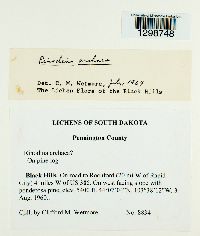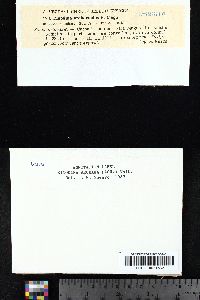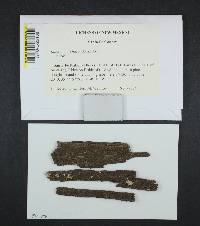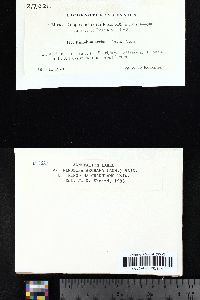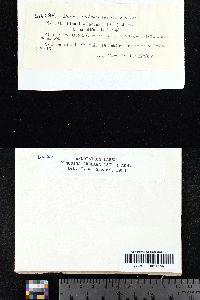
- Home
- Search
- Images
- Species Checklists
- US States: O-Z >
- US National Parks
- Central America
- South America
- US National Parks
- Southern Subpolar Region
|
|
|
|
Family: Physciaceae
[Rinodina lignicola Sheard] |
MB#404216 Basionym: Parmelia sophodes var. archaea Ach., Meth. Lich: 156 (1803). = Rinodina lignicola Sheard, Bryologist 105: 663 (2002). Exsicatae. Norrlin & Nyl. Herb. Lich. Fenn. 157 (M, as Lecanora sophodes * laevigata); Malme Lich. Suec. Exs. 584 (S, as R. archaea f. paupera); Mougeot & Nestler Stirpes Crypt. Vogeso-Rhenanae 1330 (M, as Lecidea vernalis v. anomala); Räsänen Lich. Fenn. 477 (M); Roumeguère Lich. Gallici Exs. 221 (M, as Lecanora sophodes v. laevigata); Vězda Lich. Sel. Exs. 2296 (CANL as R. arctica). Description. Thallus thin or thick, rarely absent, dark grey to brownish, discontinuous, of scattered areoles; areoles to 0.15-0.35 mm wide, then coalescing, thallus becoming continuous to rimose, or more typically areolate; areoles to 0.50-1.00 mm wide; surface plane to minutely verrucose, matt; margin indeterminate; prothallus lacking; vegetative propagules absent. Apothecia abundant, sometimes subinnate, almost erumpent, typically broadly attached, rarely narrowly attached, often becoming contiguous, to 0.40-0.90 mm in diam.; disc persistently plane to slightly convex, rarely becoming half-globose, red-brown to black; thalline margin concolourous with thallus or darker brown, entire and persistent, 0.05-0.10 mm wide; excipular ring sometimes present, confluent. Apothecial Anatomy. Thalline exciple 40-80 µm wide laterally; cortex 5-10 µm wide; epinecral layer absent or ca. 10 µm wide; crystals absent in cortex and medulla; cortical cells to 4.0-6.5 µm wide, pigmented or not; algal cells to 9.5-15.5 µm long; thalline exciple (30-)40-100 µm wide below when apothecia narrowly attached; cortex cellular to intricate, 10-50 µm deep; proper exciple 5-20 µm wide, rarely pigmented, expanding to 10-40 µm wide above; hypothecium hyaline, (30-)40-80 µm deep; hymenium (50-)60-100 µm high, not inspersed, paraphyses 1.5-2.5 µm wide, often conglutinate, apices to 3.5-5.0 µm wide, lightly pigmented, immersed in dispersed pigment, forming a red-brown epihymenium; asci 40-70 x 14-21 µm. Ascospores 8/ascus, Type A development, Physconia-type (Figure 11), (15.5-)19.0-20.0(-23.5) x (7.5-)9.0-9.5(-11.0) µm, average l/b ratio 2.1-2.3, apical walls thickened only during development (Physcia-like); torus present; walls ornamented or not. Pycnidia not seen. Chemistry. Spot tests all negative; secondary metabolites, zeorin (trace). Substrate and Ecology. The species is typically lignicolous but also occurs on rough bark of deciduous trees and conifers. Recorded on Betula, the wood of Castanea sativa and Picea, and other woods in Europe. In western North America the species has been collected on Abies concolor, A. lasiocarpa, A. magnifica, Artemisia, Juniperus monosperma, Larix occidentalis, Picea, Populus tremuloides and Pseudotsuga menziesii. Sometimes found in nutrient rich environments at the base of trees and their exposed roots adjacent to trails. Found on seashore driftwood on the Haida Gwaii (Queen Charlotte Islands), British Columbia, otherwise recorded from elevations of 690-3 600 m. The species has been collected with R. boulderensis, R. conradii and R. macrospora. Distribution. Rinodina archaea is a western species with a Rocky Mountain distribution with outliers in the Northwest Territories, coastal British Columbia, the mountains of Southern California and extending southwards through Arizona to Big Bend Nat. Park, Texas. The single Northwest Territories record may be comparable with the with records from Spitsbergen (Mayrhofer and Sheard, 2007). First reported for North America from the Black Hills by Wetmore (1968) although these records also include R. coloradiana, R. juniperina and R. metaboliza. Two records reported as R. lignicola by Sheard & Mayrhofer (2002) belong to R. juniperina (Wetmore 6608, South Dakota; Nash 15549, Utah). Widespread in Scandinavia, also known from continental Europe and Siberia. Notes. Rinodina archaea is usually characterized by its broadly attached apothecia and rather persistently plane apothecia, and by its relatively large Physconia-type spores. It has previously been confused with R. trevisanii in Europe (Ropin & Mayrhofer 1993, Giralt & Mayrhofer 1995, Mayrhofer & Moberg 2002). Both species possess Physconia-type spores often characterized by narrow, elongate lumina canals early in development but the spores of R. archaea are significantly larger. North American material, included in R. lignicola by Sheard & Mayrhofer (2002), is often characterized by more rapid spore development and consequently by more transient narrow canals. The thallus of R. archaea is thick and matt, and becomes areolate in comparison to the thin, smooth or shining, continuous or rimose thallus of R. trevisanii. In addition, the apothecia of R. archaea often become contiguous and angular by compression, their discs remaining plane and margins persistent, in contrast to the scattered apothecia of R. trevisanii with discs frequently becoming convex and their margins biatorine. These differences are summarized in Table 2. The thallus of R. archaea is better developed in mesic environments, except in the extreme case of its occurrence on marine driftwood in the Pacific Northwest where the thallus may be almost absent. Both of these species possess a higher proportion of spores in the Physcia-like developmental stage in their most mesic (faster growth?) habitats. Rinodina orculata is distinguished from both of these species by its smaller average spore size and more prominent torus. Larger spores of this species also tend to retain a slightly thickened apical spore wall. Rinodina subobscura H. Magn. was included in R. archaea by Mayrhofer & Moberg (2002) and R. archaeoides H. Magn. by Thomson (1997). According to Mayrhofer and Sheard (2007) both species belong to R. olivaceobrunnea Dodge and Baker but see R. orculata for further discussion on R. subobscura. Records of R. archaea var. cinerascens H. Magn. from North America (Magnusson 1953) belong to R. polyspora (Thomson 2168, UPS, WIS) and R. subminuta (Thomson 1122, UPS). Specimens examined [additional to those listed in Sheard & Mayrhofer (2002) under R. lignicola]. CANADA. ALBERTA. Bow River Forest Reserve, 1966, S.D. MacDonald (CANL); Dutch Creek, C.D. Bird 15916; Glenevis, G.R. Pegg 1582 (both PMAE); Rocky Mountain House, M.E. Hale 43458 (GZU); Shunda Creek Campground C.M. Wetmore 20055 (MIN). BRITISH COLUMBIA. Haida Gwaii (Queen Charlotte Islands), Cape Graham Island, I.M. Brodo 9859 (both CANL); Masset Inlet, I.M. Brodo 18348B (CANL, MIN); Naden Harbour, I.M. Brodo 10702 (CANL); 2 mi SE Sandspit, I.M. Brodo 17148 (CANL, H); St. James, I.M. Brodo 17634; Talunkwan Island, I.M. Brodo 12107 (all CANL); Mara, J.W. Sheard 5274 (SASK); Vancouver Island, Ucluelet, T. Ahti 42911 (H); Wells Gray Prov. Park, T. Ahti 38681 (H); I.M. Brodo 27294 (CANL). N.W.T. Mackenzie District, Crossley Lakes, G.W. Scotter 8328C (H). U.S.A. ALASKA. Borough of Juneau, Sunshine Cove, I.M. Brodo 26009 (CANL). ARIZONA. Cochise Co., Portal, W.A. Weber 14101 (COLO); Coconino Co., San Francisco Mountain, T.H. Nash 7482a (ASU, COLO, MIN), 7553, 7477; W Fork Oak Creek Canyon, T.H. Nash, 9283b; Pima Co., Mount Lemon, T.H. Nash 21198a. CALIFORNIA. Madera Co., Owl Creek, B.D. Ryan 32187d (all ASU); Tulare Co., N Colony Mill, C.M. Wetmore 50377; Sequoia Nat. Park, C.M. Wetmore 50623, 50729, 50822. COLORADO. Boulder Co., 12 mi W Boulder, W.A. Weber 69226 (all MIN); Boulder, R.A. Anderson 30098; Boulder Canyon, W.A. Weber 2516 (both COLO); Gold Hill, C.M. Wetmore 16118 (BRY, CANL, MIN); Green Mountain, S. Shushan S4842 (COLO); Green Mountain, W.A. Weber S4832 (COLO, UPS); Gregory Canyon, J.W. Sheard 4666a, 4670a (SASK); Longs Peak, W. Kiener 8543 (MIN, WIS); Lower Gregory Canyon, J.W. Sheard 4681, 4762 (SASK); Middle Saint Vrain, W. Kiener 8581, 8682; Ptarmigan R.A. Anderson 3132; Wild Basin, R.A. Anderson 1641, R.A. Anderson, 03828 (all COLO); El Paso Co., Minnehaha, 1904, F.E. Clements (NY); Larimer Co., Horseshoe Park, R.A. Anderson 2820 (COLO); Longs Peak, 1939, W. Kiener (PMAE); W. Kiener 8543 (BRY, NY); McGregor Mountain, R.A. Anderson 4071 (COLO); Poudre Canyon road, J.W. Thomson 23198 (WIS); Rocky Mountain Nat. Park, W.A. Weber 53367; S Lateral Moraine, R.A. Anderson 2624 (both COLO); Summit Co., Loveland Pass, I.M. Brodo 28674. MONTANA. Gallatin Co., Grotto Falls, C.M. Wetmore 81551 (MIN); Missoula Co., Missoula, R.A. Anderson 4900 (COLM); Ravalli Co., Bear Creek Canyon, B. McCune 10876; Teton Co., Teton River Canyon, B. McCune 19301 (both personal herb.). NEW MEXICO. San Miguel Co., El Porvenir, R.S. Egan 5174 (MIN). OREGON. Lincoln Co., Yaquina Bay Bridge, B. McCune 27217 (personal herb.). SOUTH DAKOTA. Custer Co., 11 mi SW Custer, C.M. Wetmore 6797 (BM, CANL, UPS, MSC); C.M. Wetmore 77983; Sylvan Lake, C.M. Wetmore 49911 (both MIN); Lawrence Co., Dalton Campground, C.M. Wetmore 10597b; Whitewood, C.M. Wetmore 11138; Pennington Co., 3 mi SW Rochford, C.M. Wetmore 7906 (all MSC); Black Hills Nat. Forest, T.H. Nash 21957 (ASU); Ditch Creek Campground, C.M. Wetmore 50031 (MIN); Rapid City, C.M. Wetmore 8127 (US, WIS); 8834 (UPS); 10597 (BM); Rochford Co., C.M. Wetmore 7906 (MIN); Seth Bullock Lookout Tower, C.M. Wetmore 8127 (MIN, MSC). WYOMING. Teton Co., 3.5 mi W Madison, C.M. Wetmore 80812 (MIN). Selected References. Wetmore (1968), Giralt (2001, Plate XVII: A), Mayrhofer & Moberg (2002, p. 100), Sheard & Mayrhofer (2002 as R. lignicola, Fig. 18), Sheard (2004, Fig. 18 as R. lignicola), Mayrhofer & Sheard (2007, Figs. 1-7). Nash, T.H., Ryan, B.D., Gries, C., Bungartz, F., (eds.) 2004. Lichen Flora of the Greater Sonoran Desert Region. Vol 2. Thallus: crustose, thin or thick, rimose or areolate, areoles up to 0.6-1 mm wide, plane or rugose, sometimes comprised of discrete verrucae, c. 0.2 mm in diam., that merge to form an uneven or verruciform thallus surface: dark gray to gray-brown, dull; margin: determinate on smooth substrates, more commonly indeterminate; prothallus: lacking; vegetative propagules: absent Apothecia: adnate, sometimes almost innate or erumpent, frequent and often contiguous, 0.5-0.9 mm in diam. disc: dark brown or black, plane, rarely becoming convex or half-globose thalline margin: 0.05-0.1 mm wide, entire or flexuose, persistent; excipular ring: often present, red-brown, confluent thalline exciple: 55-80 µm wide laterally; cortex: 5-10 µm; epinecral layer: absent or c. 10 µm wide; cortical cells: up to 4.5-6 µm wide, pigmented or not; algal cells: up to 9.5-15.5 µm in diam.; thalline exciple: expanded to 40-100 µm wide below; cortex: 10-50 µm, cellular proper exciple: hyaline, 5-20 µm wide, expanding to 10-40 µm at periphery hymenium: 70-100 µm tall; paraphyses: 1.5-2.5 µm wide, not conglutinate, with apices up to 3.5-5 µm wide, heavily pigmented, forming a dark red-brown epihymenium; hypothecium: hyaline, 40-80 µm thick asci: clavate, 45-70 x 14-19 µm, 8-spored ascospores: brown, 1-septate, ellipsoid, type A development, Physconia-type, (16-)19-20.5(-23.5) x (7.5-)9-9.5(-11) µm, with thick apical walls and broad lumina canals at first (Physcia-like), lumina quickly becoming rounded and spores thin walled; torus: present in most spores; walls: not ornamented Pycnidia: not seen Spot tests: all negative Secondary metabolites: zeorin (trace) and unidentified substance 4/5/5 (trace). Substrate and ecology: on conifers and frequently on wood, sometimes in nutrient rich environments such as the base of tree trunks and their exposed roots adjacent to trails, at elevations of 1000-3500 m World distribution: widespread in Scandinavia and Siberia, also know further south in Europe, and North America (very similar to distribution of R. juniperina but extending further north into Montana and Alberta, and west into California) Sonoran distribution: southern California and Arizona. Notes: Rinodina archaea is perhaps most closely related to R. trevisanii. Their Physconia-type spores at maturity are characterized by relatively thin and elongate lumina canals during early development. This character is, however, more apparent in European than North American material that was recently described as R. lignicola (Sheard & Mayrhofer 2002). It is now apparent that more rapid development of the spores in North American specimens only makes this feature more transient and difficult to observe. Rinodina archaea is otherwise easily distinguished from R. trevisanii by its larger spores, thicker thallus, and apothecia that typically become contiguous and sometimes angular by compression, the plane apothecial discs, and thalline margins that never become biatorine. |






